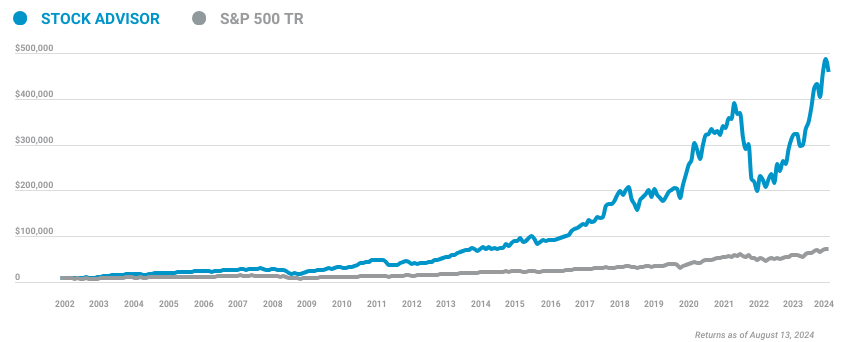Investing in growth stocks can be a great way to earn life-changing wealth in the stock market. The key, of course, is to know which growth stocks to buy -- and when.
Many growth stocks have been routed through the first half of 2022. While the S&P 500 index crashed about 20%, the S&P 500 Growth index fell 28% through the first six months of 2022. Some growth stocks fell much more, with stock prices cut by half or two-thirds. If you can identify a growth stock with strong fundamentals, now could be a great opportunity to invest.
To help you get started, here’s a handy guide to growth investing. With these tools and strategies, you’ll be able to position your portfolio for long-term success with growth stocks.
What is a growth stock?
Growth stocks are companies that increase their revenue and earnings at a faster rate than the average business in their industry or the market as a whole. Growth investing, however, involves more than picking stocks that are going up.
Often, a growth company has developed an innovative product or service that is gaining share in existing markets, entering new markets, or even creating entirely new industries.
Businesses that can grow faster than average for long periods tend to be rewarded by the market, delivering handsome returns to shareholders in the process. And, the faster they grow, the bigger the returns can be.
Unlike value stocks, high-growth stocks tend to be more expensive than the average stock in terms of profitability ratios, such as price-to-earnings, price-to-sales, and price-to-free-cash-flow ratios.
Despite their premium price tags, the best growth stocks can still deliver fortune-creating returns to investors as they fulfill their awesome growth potential.
That said, growth stocks have taken a beating in the market in 2022. High inflation has put pressure on growth stocks since it reduces the future value of their expected earnings. Additionally, supply chain constraints have impacted the ability of some to scale, while other macroeconomic factors impact the entire economy. But the downturn may give long-term investors a buying opportunity while growth stock prices are low.
Growth stocks are companies that increase their revenue and earnings faster than the average business in their industry or the market as a whole.
Great growth stocks
To provide you with some examples, here are 10 excellent growth stocks available in the stock market today:
| Company | 3-Year Sales Growth CAGR | Industry |
|---|---|---|
| Tesla (NASDAQ:TSLA) | 40% | Automotive |
| Shopify (NYSE:SHOP) | 52% | E-commerce |
| Block (NYSE:SQ) | 56% | Digital payments |
| Etsy (NASDAQ:ETSY) | 48% | E-commerce |
| MercadoLibre (NASDAQ:MELI) | 63% | E-commerce |
| Netflix (NASDAQ:NFLX) | 18% | Streaming entertainment |
| Amazon (NASDAQ:AMZN) | 22% | E-commerce and cloud computing |
| Meta Platforms (NASDAQ:FB) | 22% | Digital advertising |
| Salesforce.com (NYSE:CRM) | 21% | Cloud software |
| Alphabet (NASDAQ:GOOG), (NASDAQ:GOOGL) | 22% | Digital advertising |
As this list shows, growth stocks come in all shapes and sizes. They can be found in a variety of industries, both within the U.S. and in international markets. And, although all the stocks on this list are larger businesses, smaller companies can be fertile ground for growth investors, too.
A great way to invest in a wide variety of small-cap growth stocks is via an exchange-traded fund (ETF) such as Vanguard Small-Cap Growth ETF (NYSEMKT:VBK). This fund tracks the performance of the CRSP US Small Cap Growth Index, which gives investors an easy way to invest in roughly 580 small-cap growth companies all at once.
Importantly, the Vanguard Small-Cap Growth ETF has an ultra-low expense ratio of 0.07%. This means investors will receive almost all of the fund’s returns, with only a small amount in fees going to Vanguard. (An annual expense ratio of 0.07% equates to only $0.70 in fees per $1,000 invested per year.)
How to find growth stocks
To find great growth stocks, you’ll need to:
- Identify powerful long-term market trends and the companies best positioned to profit from them.
- Narrow your list to businesses with strong competitive advantages.
- Further narrow your list to companies with large addressable markets.

Identify trends and the companies driving them
Companies that can capitalize on powerful long-term trends can increase their sales and profits for many years, generating wealth for their shareholders along the way.
The COVID-19 pandemic accelerated many trends that were already well underway. Here are some examples, along with the companies that can help you profit from those trends:
- E-commerce: As more people shop online, Amazon, Shopify, and Etsy are well-positioned to profit within the U.S. (and many international markets). MercadoLibre holds a leading share of the online retail market in Latin America. While consumers have started to return to physical stores in 2022, e-commerce still has tons of growth potential as an industry.
- Digital advertising: Meta (formerly Facebook) and Alphabet own the lion’s share of the digital ad market and are poised to profit handsomely as marketing budgets shift from TV and print to online channels. Amazon has built a massive advertising business, which continues to expand into new formats. Even Netflix is starting to come around to advertising as a way to increase its subscriber base and boost its revenue.
- Digital payments: Block (formerly Square) is helping to accelerate the global shift from cash to digital forms of payment by allowing businesses of all sizes to accept debit and credit card transactions.
- Cloud computing: Computing power is migrating from on-premise data centers to cloud-based servers. Amazon and Google’s cloud infrastructure services help make this possible, while Salesforce.com provides some of the best cloud-based enterprise software available.
- Cord-cutting and streaming entertainment: Millions of people are canceling their cable subscriptions and replacing them with less expensive and more convenient streaming options. As the global leader in streaming entertainment, Netflix offers a great way to profit from this trend, but it does face growing competition from other media companies.
- Remote work: For many organizations, remote work arrangements became a necessity during the pandemic. Studies indicate that the remote work trend will continue well after the pandemic is over as companies realize the financial efficiencies and workforce benefits associated with flexible working arrangements.
- Electric vehicles: The world is shifting from its reliance on gasoline to using electricity to power vehicles. Half of all auto sales could be EVs by 2030, according to a survey of industry executives. Tesla is the leader in the space with its lineup of vehicles and its battery technology.
The key is to try to invest in these types of trends and companies as early as possible. The earlier you get in, the more you stand to profit. However, the most powerful trends can last for many years and even decades, giving you plenty of time to claim your share of the profits they create.
In 2022, the market has seen many great companies' share prices plummet. During times when the entire market is down, growth investors pay close attention.
Prioritize companies with competitive advantages
It’s also important to invest in growth companies that possess strong competitive advantages. Otherwise, their competitors may pass them by, and their growth may not last long.
Competitive advantages become especially important during turbulent times such as the pandemic or periods of high inflation. A strong competitive advantage will help companies survive and thrive through market downturns, while those without a competitive advantage will struggle.
In fact, the start of 2022 saw a big sell-off in many tech-focused growth stocks. Many share prices of top growth stocks were slashed by more than 50%. If you can identify stocks of companies with strong competitive advantages that are being sold off along with the rest of the market, it could be an opportunity to generate massive returns as they recover.
Some competitive advantages are:
- Network effects: Meta’s Facebook is a prime example here. Each person who joins its social media platform makes it more valuable to other members. Network effects can make it difficult for new entrants to displace the current market share leader, and Facebook’s 2.9 billion users certainly make it unlikely that a new social media company will displace it.
- Scale advantages: Size can be another powerful advantage. Amazon is a great example in this category because its massive global fulfillment network is something its smaller rivals will find extremely difficult to replicate.
- High switching costs: Switching costs are the expenses and difficulties involved in switching to a rival product or service. Shopify -- which serves as an online retail system for more than 1 million businesses -- is a perfect example of a business with high switching costs. Once a company begins to use Shopify as the core of its online operations, it’s unlikely to go through the hassle of switching to a competitor.
Related investing topics
Find companies with large addressable markets
Finally, you’ll want to invest in businesses with large addressable markets -- and long runways for growth still ahead. Industry reports from research firms such as Gartner (NYSE:IT) and eMarketer -- which provide estimates of industry sizes, projections for growth, and market share figures -- can be very helpful in this regard.
The larger the opportunity, the larger a business can ultimately become. And, the earlier in its growth cycle it is, the longer it can continue to grow at an impressive rate.
Expert Q&A on Growth Stocks

Dr. Preston D. Cherry, PhD, CFP
The Motley Fool: What's your best advice on finding high potential stocks like growth stocks?
Dr. Cherry: Because growth stocks tend to operate in a growth business cycle or business sector, finding high potential growth stocks should contain metrics that attempt to confirm or support current growth and best signal sustainable growth patterns. One important feature of a growth company is to ask, "do they possess a unique business service or product in their sector that provides a valuable moat?" This service or product is the lifeline of growth where the company needs to market, produce, deliver, and protect better than competitors and new entrants. Performance metrics to consider are whether the company shows historical increases in earnings over select periods and profit margin analysis, which illustrates how a company can manage costs and increase revenues. Other analysis considerations are the technical chart trend characteristics and experienced market analysts' forward growth and price projections.
The Motley Fool: Are growth stocks risky?
Dr. Cherry: Investing in individual stocks, in general, contains risk factors such as overall market risk and business risk, among others. The characteristics of growth stocks can make them riskier than their value stock counterparts. As their name suggests, growth stock companies tend to be in a growing business phase. The growing stage could consist of younger and smaller companies with an unproven product or entity track record that tend to use much of their revenues and raised capital to grow the business. These growth characteristics, among others, tend to make growth stocks riskier through higher stock price volatility or reactions to market, company, economic, and political risks, to name a few, thus more significant exposure to downside stock price pressure. However, as investors should avail themselves of the downside cautions of growth stock risk, the upside potential should also be considered. With additional risk comes the prospect of added returns. Because growth companies have the potential for higher company growth rates, growing from earlier business stages to mature business stages, growth stocks could potentially experience higher returns over shorter time horizons. Above all, investors should consider their risk tolerance, capacity, portfolio allocations, and goals to accept the higher risk of growth stocks.
The Motley Fool: How do you tell the difference between a growth vs. value stock?
Dr. Cherry: Growth and value stocks tend to differ in a few areas, such as company size, business stage, and revenues to return gains to the shareholder. Growth stocks tend to be in the emerging markets or small or mid-cap company size areas whereas value stock companies tend to be large-cap. The size of companies tends to be the lens of what business stage a company resides. Growth stocks tend to be in the early to mid-business stages, the growth stages (although a small segment of large companies can be growth companies too), and value stock companies tend to be larger, more mature business stage companies. The value stock companies tend to be trading at a discount, "on-sale," or a premium, "overvalued," to their valuation, thus their name, finding value. Growth stock companies tend to reinvest their earnings back into the company and return value to shareholders solely through stock price appreciation. In comparison, value companies may return earnings to investors through a dividend, representing income to an investor and complements stock price appreciation. This income and stock price appreciation mean a total return approach.

Scott Stewart, PhD
The Motley Fool: How do you tell the difference between a growth vs. value stock?
Dr. Stewart: The Gordon valuation model is an excellent tool to illustrate the difference between growth and value stocks. Professor Gordon’s model, with some simplifying assumptions, shows that stock prices equal next year’s earnings (e) divided by the expression r – g, where “r” is a discount rate and “g” is a growth rate. For the same stock price, a lower growth rate necessitates a higher earnings number. Conversely, (illustrated by dividing both sides by e) a high-p/e stock is associated with a high growth rate. Of course, these numbers reflect investor expectations.
Investors bid up the p/e ratios of some stocks because, despite low current earnings relative to their market values, they expect earnings to grow at high rates. These are traditionally defined as growth stocks. Tesla stock is a good example of a growth stock, with its 154 p/e multiple and 73% earnings growth rate (using Yahoo Finance data).
The Motley Fool: Are growth stocks risky?
Dr. Stewart: Note that a company’s risk is embedded in its discount rate “r.” As a result, companies with stable earnings will justify higher p/e multiples than ones with volatile earnings, other things equal. Clorox, a large-cap, stable-earnings company with only modest growth expectations (basically 0% using Yahoo Finance data) still justifies a p/e of 30 (using next fiscal year’s earnings).
Empirical evidence suggests that high-growth stocks underperform low-growth, low-p/e “value” stocks over the very long term. For example, the Russell small-cap Value index yielded roughly 3% a year higher than its Growth peer over the forty years ending 2019, and at lower return volatility. One explanation is that investors over-estimate the sustainability of high-growing companies since these “glamour” stocks subsequently fail to deliver on those high expectations. However, there can be long periods in which growth stocks outperform, such as the 10 years ending 2020.
The theory and evidence suggest that the key to picking good growth stocks is to identify the ones whose earnings growth rates will accelerate in the short term (increasing the p/e and price) and not disappoint in the long term (sustaining e growth and maintaining a high p/e). For value stocks, some practitioners suggest picking companies that investors have given up on (ones with very low-p/e or other multiples if e is less than zero), that won’t fail in the short-term and will recover in the long-term. Not easy tasks!



















